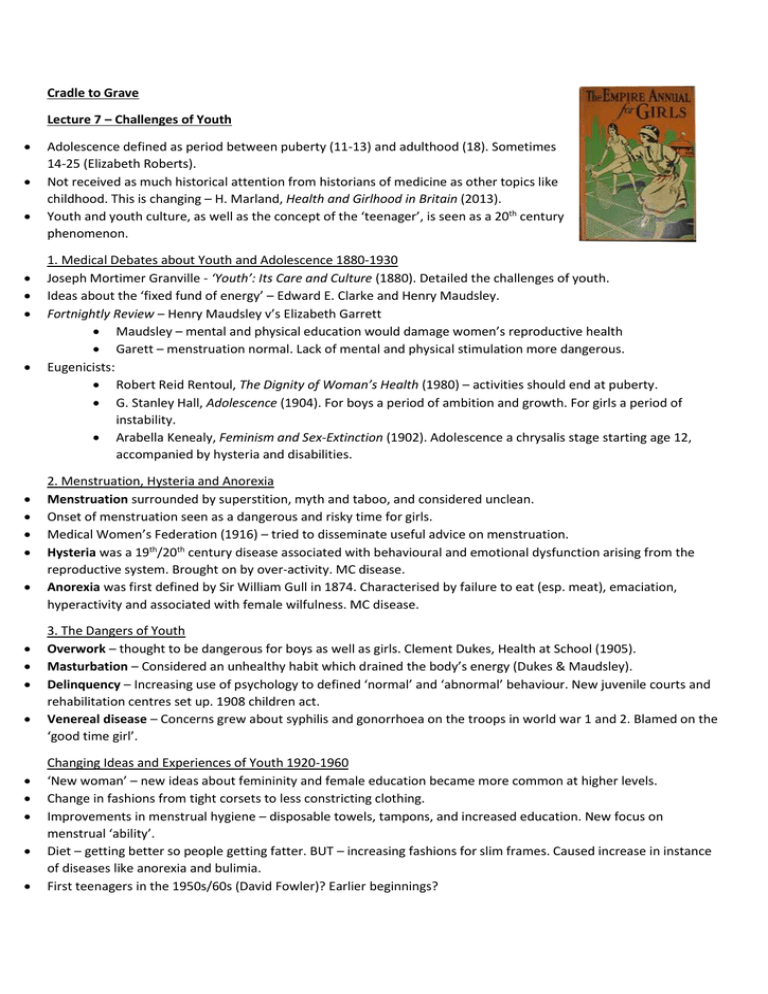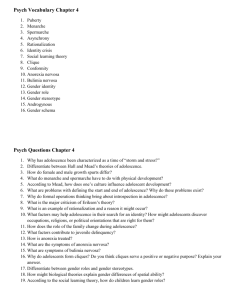Cradle to Grave Lecture 7 – Challenges of Youth 14-25 (Elizabeth Roberts).
advertisement

Cradle to Grave Lecture 7 – Challenges of Youth Adolescence defined as period between puberty (11-13) and adulthood (18). Sometimes 14-25 (Elizabeth Roberts). Not received as much historical attention from historians of medicine as other topics like childhood. This is changing – H. Marland, Health and Girlhood in Britain (2013). Youth and youth culture, as well as the concept of the ‘teenager’, is seen as a 20th century phenomenon. 1. Medical Debates about Youth and Adolescence 1880-1930 Joseph Mortimer Granville - ‘Youth’: Its Care and Culture (1880). Detailed the challenges of youth. Ideas about the ‘fixed fund of energy’ – Edward E. Clarke and Henry Maudsley. Fortnightly Review – Henry Maudsley v’s Elizabeth Garrett Maudsley – mental and physical education would damage women’s reproductive health Garett – menstruation normal. Lack of mental and physical stimulation more dangerous. Eugenicists: Robert Reid Rentoul, The Dignity of Woman’s Health (1980) – activities should end at puberty. G. Stanley Hall, Adolescence (1904). For boys a period of ambition and growth. For girls a period of instability. Arabella Kenealy, Feminism and Sex-Extinction (1902). Adolescence a chrysalis stage starting age 12, accompanied by hysteria and disabilities. 2. Menstruation, Hysteria and Anorexia Menstruation surrounded by superstition, myth and taboo, and considered unclean. Onset of menstruation seen as a dangerous and risky time for girls. Medical Women’s Federation (1916) – tried to disseminate useful advice on menstruation. Hysteria was a 19th/20th century disease associated with behavioural and emotional dysfunction arising from the reproductive system. Brought on by over-activity. MC disease. Anorexia was first defined by Sir William Gull in 1874. Characterised by failure to eat (esp. meat), emaciation, hyperactivity and associated with female wilfulness. MC disease. 3. The Dangers of Youth Overwork – thought to be dangerous for boys as well as girls. Clement Dukes, Health at School (1905). Masturbation – Considered an unhealthy habit which drained the body’s energy (Dukes & Maudsley). Delinquency – Increasing use of psychology to defined ‘normal’ and ‘abnormal’ behaviour. New juvenile courts and rehabilitation centres set up. 1908 children act. Venereal disease – Concerns grew about syphilis and gonorrhoea on the troops in world war 1 and 2. Blamed on the ‘good time girl’. Changing Ideas and Experiences of Youth 1920-1960 ‘New woman’ – new ideas about femininity and female education became more common at higher levels. Change in fashions from tight corsets to less constricting clothing. Improvements in menstrual hygiene – disposable towels, tampons, and increased education. New focus on menstrual ‘ability’. Diet – getting better so people getting fatter. BUT – increasing fashions for slim frames. Caused increase in instance of diseases like anorexia and bulimia. First teenagers in the 1950s/60s (David Fowler)? Earlier beginnings?




